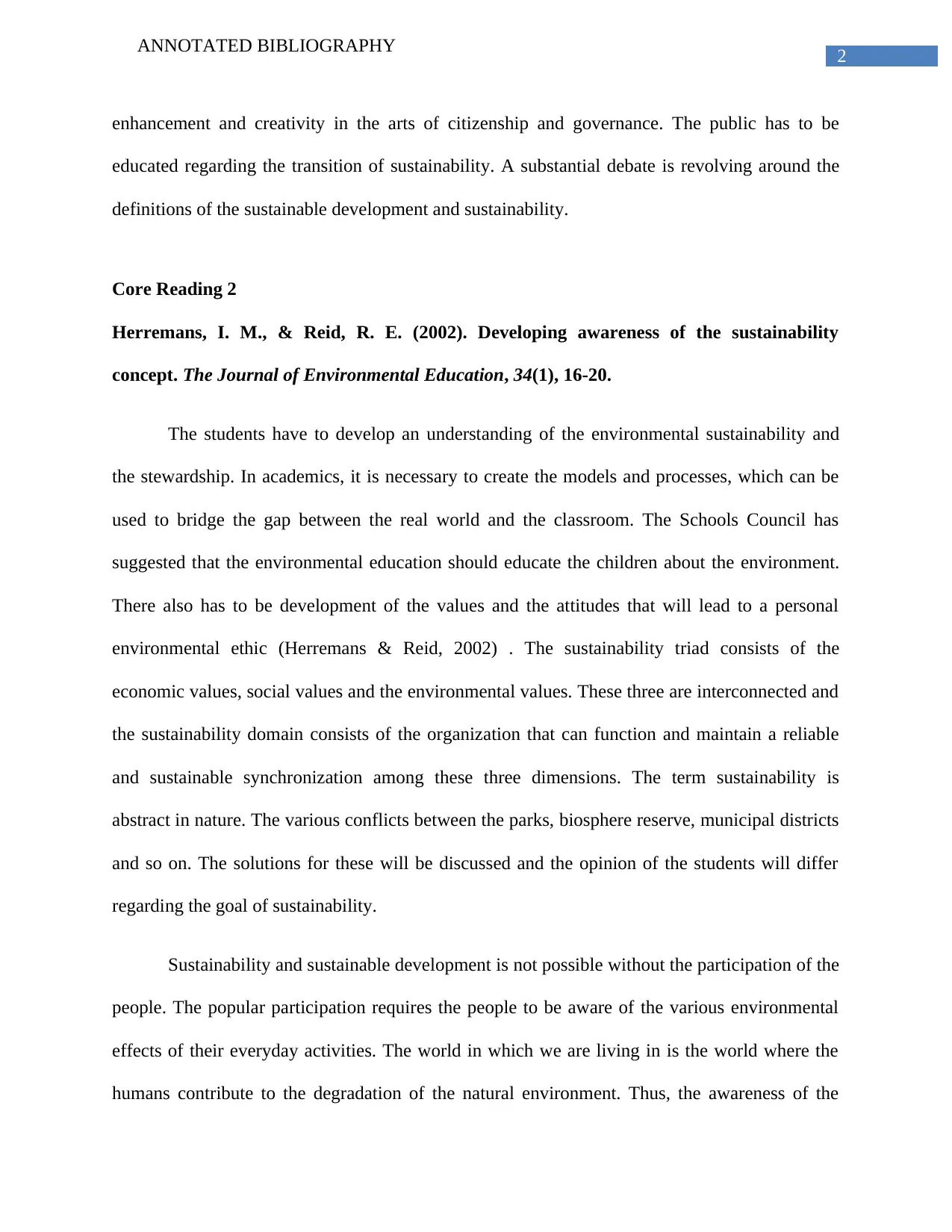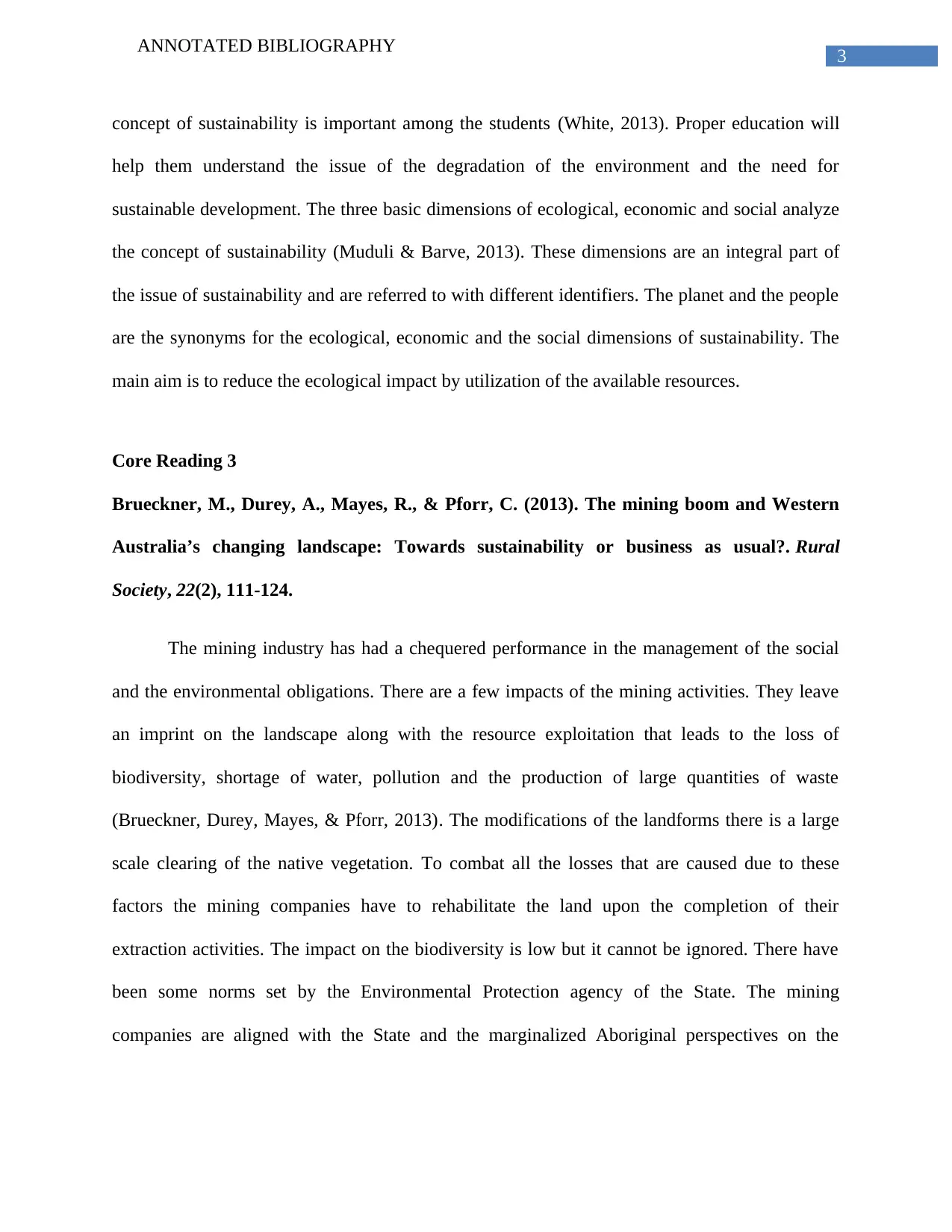Annotated Bibliography: Exploring Sustainability Concepts
VerifiedAdded on 2020/02/24
|7
|1209
|182
Annotated Bibliography
AI Summary
This annotated bibliography explores the multifaceted concept of sustainability through three core readings. The first reading defines sustainability as a response to environmental challenges, emphasizing the interdisciplinary nature of the field and the importance of balancing environmental, economic, and social factors. The second reading focuses on the educational aspect, highlighting the need to develop environmental awareness and stewardship among students. It underscores the interconnectedness of economic, social, and environmental values, and the role of education in fostering sustainable practices. The final reading examines the impact of the mining industry on sustainability, detailing the environmental and social consequences of resource extraction. It emphasizes the need for responsible mining practices and land rehabilitation to minimize negative impacts and ensure long-term sustainability. Overall, the bibliography provides a comprehensive view of sustainability from different perspectives and encourages a holistic approach to environmental management.

Running head: ANNOTATED BIBLIOGRAPHY
Annotated Bibliography
Name of the Student
Name of the University
Author Note
Annotated Bibliography
Name of the Student
Name of the University
Author Note
Paraphrase This Document
Need a fresh take? Get an instant paraphrase of this document with our AI Paraphraser

1
ANNOTATED BIBLIOGRAPHY
Core Reading 1
AUSTRALIA, C. O. (1969). Copyright Regulations 1 969 Warning
Sustainability is the recognition of the dynamic, cyclical and the interdependent nature of
all the things that belong to nature. It is the response to all the threats and challenges that the
planet is facing at present. Sustainability is the process and the system, which operates and
persists over a long period. The planet Earth is rich in its natural resources and theses are
available in the ecosystem to satisfy the needs of the human beings. There are different
diversities on this planet and each individual has his or her own needs to satisfy. Sustainability is
the process by which the activities of the humans do not lead to economic degradation and
comprises of the three ‘E’s’ respectively (University, 1969). These are environment, economics
and equity. They represent preservation and restoration of the planet maintaining the economy
and the equity. The issue of sustainability is critical as the population on this planet is increasing
at a tremendous rate and there is scarcity in the planet. The challenge facing the formation of
sustainability as a discipline is its interdisciplinary nature.
The concept of sustainability is a complex one in nature. Sustainable development refers
to the improvement, which meets the needs of the human beings at present without negotiatind
the ability of the future generations to meet their own needs. These practices sustain the
ecological, human and the economic health and liveliness. The main presumption is that the
resources that are available on the planet are finite in nature and should be used in conservative
manner so that the priorities are met in the long term in consequence in the way these resources
are used. There is the need for precise models and measures to describe the human enterprise
relative to the biosphere (Bjørn & Hauschild, 2013). The governments need marked
ANNOTATED BIBLIOGRAPHY
Core Reading 1
AUSTRALIA, C. O. (1969). Copyright Regulations 1 969 Warning
Sustainability is the recognition of the dynamic, cyclical and the interdependent nature of
all the things that belong to nature. It is the response to all the threats and challenges that the
planet is facing at present. Sustainability is the process and the system, which operates and
persists over a long period. The planet Earth is rich in its natural resources and theses are
available in the ecosystem to satisfy the needs of the human beings. There are different
diversities on this planet and each individual has his or her own needs to satisfy. Sustainability is
the process by which the activities of the humans do not lead to economic degradation and
comprises of the three ‘E’s’ respectively (University, 1969). These are environment, economics
and equity. They represent preservation and restoration of the planet maintaining the economy
and the equity. The issue of sustainability is critical as the population on this planet is increasing
at a tremendous rate and there is scarcity in the planet. The challenge facing the formation of
sustainability as a discipline is its interdisciplinary nature.
The concept of sustainability is a complex one in nature. Sustainable development refers
to the improvement, which meets the needs of the human beings at present without negotiatind
the ability of the future generations to meet their own needs. These practices sustain the
ecological, human and the economic health and liveliness. The main presumption is that the
resources that are available on the planet are finite in nature and should be used in conservative
manner so that the priorities are met in the long term in consequence in the way these resources
are used. There is the need for precise models and measures to describe the human enterprise
relative to the biosphere (Bjørn & Hauschild, 2013). The governments need marked

2
ANNOTATED BIBLIOGRAPHY
enhancement and creativity in the arts of citizenship and governance. The public has to be
educated regarding the transition of sustainability. A substantial debate is revolving around the
definitions of the sustainable development and sustainability.
Core Reading 2
Herremans, I. M., & Reid, R. E. (2002). Developing awareness of the sustainability
concept. The Journal of Environmental Education, 34(1), 16-20.
The students have to develop an understanding of the environmental sustainability and
the stewardship. In academics, it is necessary to create the models and processes, which can be
used to bridge the gap between the real world and the classroom. The Schools Council has
suggested that the environmental education should educate the children about the environment.
There also has to be development of the values and the attitudes that will lead to a personal
environmental ethic (Herremans & Reid, 2002) . The sustainability triad consists of the
economic values, social values and the environmental values. These three are interconnected and
the sustainability domain consists of the organization that can function and maintain a reliable
and sustainable synchronization among these three dimensions. The term sustainability is
abstract in nature. The various conflicts between the parks, biosphere reserve, municipal districts
and so on. The solutions for these will be discussed and the opinion of the students will differ
regarding the goal of sustainability.
Sustainability and sustainable development is not possible without the participation of the
people. The popular participation requires the people to be aware of the various environmental
effects of their everyday activities. The world in which we are living in is the world where the
humans contribute to the degradation of the natural environment. Thus, the awareness of the
ANNOTATED BIBLIOGRAPHY
enhancement and creativity in the arts of citizenship and governance. The public has to be
educated regarding the transition of sustainability. A substantial debate is revolving around the
definitions of the sustainable development and sustainability.
Core Reading 2
Herremans, I. M., & Reid, R. E. (2002). Developing awareness of the sustainability
concept. The Journal of Environmental Education, 34(1), 16-20.
The students have to develop an understanding of the environmental sustainability and
the stewardship. In academics, it is necessary to create the models and processes, which can be
used to bridge the gap between the real world and the classroom. The Schools Council has
suggested that the environmental education should educate the children about the environment.
There also has to be development of the values and the attitudes that will lead to a personal
environmental ethic (Herremans & Reid, 2002) . The sustainability triad consists of the
economic values, social values and the environmental values. These three are interconnected and
the sustainability domain consists of the organization that can function and maintain a reliable
and sustainable synchronization among these three dimensions. The term sustainability is
abstract in nature. The various conflicts between the parks, biosphere reserve, municipal districts
and so on. The solutions for these will be discussed and the opinion of the students will differ
regarding the goal of sustainability.
Sustainability and sustainable development is not possible without the participation of the
people. The popular participation requires the people to be aware of the various environmental
effects of their everyday activities. The world in which we are living in is the world where the
humans contribute to the degradation of the natural environment. Thus, the awareness of the
⊘ This is a preview!⊘
Do you want full access?
Subscribe today to unlock all pages.

Trusted by 1+ million students worldwide

3
ANNOTATED BIBLIOGRAPHY
concept of sustainability is important among the students (White, 2013). Proper education will
help them understand the issue of the degradation of the environment and the need for
sustainable development. The three basic dimensions of ecological, economic and social analyze
the concept of sustainability (Muduli & Barve, 2013). These dimensions are an integral part of
the issue of sustainability and are referred to with different identifiers. The planet and the people
are the synonyms for the ecological, economic and the social dimensions of sustainability. The
main aim is to reduce the ecological impact by utilization of the available resources.
Core Reading 3
Brueckner, M., Durey, A., Mayes, R., & Pforr, C. (2013). The mining boom and Western
Australia’s changing landscape: Towards sustainability or business as usual?. Rural
Society, 22(2), 111-124.
The mining industry has had a chequered performance in the management of the social
and the environmental obligations. There are a few impacts of the mining activities. They leave
an imprint on the landscape along with the resource exploitation that leads to the loss of
biodiversity, shortage of water, pollution and the production of large quantities of waste
(Brueckner, Durey, Mayes, & Pforr, 2013). The modifications of the landforms there is a large
scale clearing of the native vegetation. To combat all the losses that are caused due to these
factors the mining companies have to rehabilitate the land upon the completion of their
extraction activities. The impact on the biodiversity is low but it cannot be ignored. There have
been some norms set by the Environmental Protection agency of the State. The mining
companies are aligned with the State and the marginalized Aboriginal perspectives on the
ANNOTATED BIBLIOGRAPHY
concept of sustainability is important among the students (White, 2013). Proper education will
help them understand the issue of the degradation of the environment and the need for
sustainable development. The three basic dimensions of ecological, economic and social analyze
the concept of sustainability (Muduli & Barve, 2013). These dimensions are an integral part of
the issue of sustainability and are referred to with different identifiers. The planet and the people
are the synonyms for the ecological, economic and the social dimensions of sustainability. The
main aim is to reduce the ecological impact by utilization of the available resources.
Core Reading 3
Brueckner, M., Durey, A., Mayes, R., & Pforr, C. (2013). The mining boom and Western
Australia’s changing landscape: Towards sustainability or business as usual?. Rural
Society, 22(2), 111-124.
The mining industry has had a chequered performance in the management of the social
and the environmental obligations. There are a few impacts of the mining activities. They leave
an imprint on the landscape along with the resource exploitation that leads to the loss of
biodiversity, shortage of water, pollution and the production of large quantities of waste
(Brueckner, Durey, Mayes, & Pforr, 2013). The modifications of the landforms there is a large
scale clearing of the native vegetation. To combat all the losses that are caused due to these
factors the mining companies have to rehabilitate the land upon the completion of their
extraction activities. The impact on the biodiversity is low but it cannot be ignored. There have
been some norms set by the Environmental Protection agency of the State. The mining
companies are aligned with the State and the marginalized Aboriginal perspectives on the
Paraphrase This Document
Need a fresh take? Get an instant paraphrase of this document with our AI Paraphraser

4
ANNOTATED BIBLIOGRAPHY
development of the resource of their ancestral lands (Chasin, 2014). However, the rapid resource
extraction shows the unsustainable costs and its consequences on the planet.
In order to enhance the environmental sustainability the mining operations have to be
conducted in a manner that decreases their impact on the adjacent environment leaving the mine
sites in an acceptable state so that the ecosystem and the people can reuse them. Mining occurs in
a small area. Nevertheless, the infrastructure associated with it and the pollution arising from the
mining activities affect the health of the. For the wellbeing of the humans and the environment
they also reduce their ability to provide goods and services that are necessary. The mining
companies can purify the air and water breakdown of the waste materials that can be
compromised where the ecosystems suffer from elevated levels of pollution (Murphy, 2012). The
prevention of the pollution is economic and effective and reduces the environmental impacts.
Mining is a temporary activity and the reclamation of the mine sites should aim to restore the
land that has been disturbed by the mining activities.
ANNOTATED BIBLIOGRAPHY
development of the resource of their ancestral lands (Chasin, 2014). However, the rapid resource
extraction shows the unsustainable costs and its consequences on the planet.
In order to enhance the environmental sustainability the mining operations have to be
conducted in a manner that decreases their impact on the adjacent environment leaving the mine
sites in an acceptable state so that the ecosystem and the people can reuse them. Mining occurs in
a small area. Nevertheless, the infrastructure associated with it and the pollution arising from the
mining activities affect the health of the. For the wellbeing of the humans and the environment
they also reduce their ability to provide goods and services that are necessary. The mining
companies can purify the air and water breakdown of the waste materials that can be
compromised where the ecosystems suffer from elevated levels of pollution (Murphy, 2012). The
prevention of the pollution is economic and effective and reduces the environmental impacts.
Mining is a temporary activity and the reclamation of the mine sites should aim to restore the
land that has been disturbed by the mining activities.

5
ANNOTATED BIBLIOGRAPHY
ANNOTATED BIBLIOGRAPHY
⊘ This is a preview!⊘
Do you want full access?
Subscribe today to unlock all pages.

Trusted by 1+ million students worldwide

6
ANNOTATED BIBLIOGRAPHY
ANNOTATED BIBLIOGRAPHY
1 out of 7
Related Documents
Your All-in-One AI-Powered Toolkit for Academic Success.
+13062052269
info@desklib.com
Available 24*7 on WhatsApp / Email
![[object Object]](/_next/static/media/star-bottom.7253800d.svg)
Unlock your academic potential
Copyright © 2020–2025 A2Z Services. All Rights Reserved. Developed and managed by ZUCOL.




